
Families shape who we become, and when addiction takes root, its ripple effects touch every member across generations. In The Streets to the Shelter: One Man’s Journey from Addiction to Redemption, Shawn Lemison shows how family is both the wound and the medicine—the source of pain, but also the key to healing.
The book opens with Shawn as a child, captivated by his father, a California Highway Patrol officer who symbolized authority, safety, and pride. That admiration formed the foundation of Shawn’s sense of belonging. But when his parents separated, the bond cracked. His father’s remarriage and emotional distance left Shawn struggling to reconcile the man he idolized with the man who seemed to move on without him. For Shawn, “Dad” became simply “father”—a linguistic and emotional downgrade that mirrored his loss of connection.
Family systems theory tells us that the parent-child relationship is central to identity formation. When that bond fractures, children often internalize feelings of abandonment and inadequacy. For Shawn, the “father wound” shaped his rebellion, relationships, and eventual reliance on drugs.
At just seven years old, Shawn’s mother told him he was now “the man of the house.” This moment illustrates how family dynamics can distort childhood. Instead of years of play and growth, he was burdened with responsibilities he could not fulfill. Such parentification—where children assume adult roles—often leaves lasting scars. It fosters resilience but also resentment, creating confusion about identity and worth. For Shawn, the weight of responsibility magnified his father’s absence and fueled the resentment that simmered into adolescence.
His family story also includes the complexity of blended households. Living with his father and stepmother in Sacramento, Shawn faced constant comparison with stepbrothers, which reinforced his feelings of inferiority. In many families, blended dynamics create competition for attention and validation. For Shawn, those comparisons deepened his insecurities and pushed him to seek belonging elsewhere—eventually in drug culture and subcultures that rewarded risk-taking.
Family is not just where we come from—it is also what we try to build. Shawn’s marriage shows how addiction seeps into new family units, eroding love and trust. Initially, there was hope. He and his wife dreamed of starting a family through IVF. But when financial pressures mounted, they agreed to sell drugs to save money. What began as a plan to build a family became the very thing that tore it apart.
As Shawn’s addiction worsened, his wife joined him in meth use. Their marriage collapsed, not from lack of love, but because addiction reshaped their foundation. Family scholars often point to the “stress process model,” which shows how financial and emotional strain compound in intimate relationships, increasing conflict and unhealthy coping. Shawn’s story illustrates this model with painful clarity.
Another powerful theme is rebellion. Shawn’s descent into drug dealing was not only personal but familial. In many ways, he became the opposite of his father. While his father represented the law, Shawn embraced lawlessness. While his father symbolized discipline, Shawn embodied chaos. This inversion reflects what family psychologists call “intergenerational opposition”—children defining themselves not by emulating their parents but by rejecting them. Shawn’s rebellion was a protest against abandonment, a symbolic rejection of the family legacy he felt he could never live up to.
Addiction, however, never confines itself to the individual. It consumes the family around them. Shawn’s mother endured heartbreak, watching her son unravel. His wife lost her marriage, health, and stability. His father carried disappointment, forced to reconcile the image of his son with the reality of his choices. In family studies, this is the collateral damage of addiction: each family member is drawn into roles—enabler, rescuer, victim, or scapegoat. Shawn’s story captures this painful dynamic, reminding readers that addiction is never isolated to one person.
The book’s final chapters shift toward reflection and redemption. For Shawn, recovery is not only about sobriety but also about repairing the bonds addiction strained and sometimes broke. Healing, from a family perspective, is relational. It involves rebuilding trust, seeking forgiveness, and reconnecting with those who bore the weight of the struggle. The letters and reflections included in the appendices underscore this process, showing his effort to re-enter the narrative of his family as a son, brother, and potential father who has grown from his mistakes.
The Streets to the Shelter ultimately reminds us that addiction is not a solitary battle but a family crisis. It shows how early dynamics—divorce, abandonment, step-family tensions—create vulnerabilities. It demonstrates how adult family life—marriage, financial strain, unfulfilled dreams—becomes entangled in the cycle of addiction. And it affirms that redemption, too, is a family affair: recovery requires not just sobriety but reconciliation, forgiveness, and love.
For families walking alongside someone in addiction, Shawn’s memoir offers both warning and hope. It reveals the hidden toll of broken bonds, but it also points to the possibility of rebuilding. Family may be where wounds begin, but it is also where healing can take root.
© Copyright 2025 Shawn Lemison All Rights Reserved